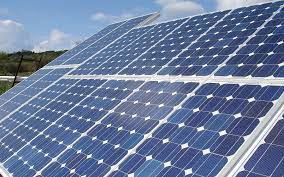
On that Tinubu’s N10b Mini Solar Grid in the Presidential: Matters Arising
By Dr Uche Diala
I really did not want to write anything on the trending news of the Tinubu administration budgeting N10 billion in the approved 2025 budget for the “solarisation of the (presidential) villa with Solar Mini Grid”.
The project is reportedly expected to reduce dependence on the national grid and to cut energy costs for the State House, especially considering that the Abuja Electricity Distribution Company (AEDC) listed the Presidential Villa among top government debtors, with an outstanding bill of N923.87 million in February 2024 (The Sun Nigeria).
However, I have read quite a bit from some people, including one who asked, on Comrade Hajara Usman’s wall, if the (US) White House does not use solar energy. I have also read similar arguments from some others.
I therefore decided to weigh in. I hope this can give some perspective to some individuals who seem not to understand why many Nigerians are appalled at that particular piece of information.
First, Some Comparative Data and Context.
The United States of America has a total installed electric generating capacity of approximately 1,250 gigawatts (GW). That is 1,250,000 Megawatts (MW).
This capacity is distributed across a mix of energy sources, with natural gas being the largest contributor, followed by renewable energy (solar and wind), coal, nuclear, and hydroelectric power.
DETAILED BREAKDOWN
▪︎Total Installed Capacity: Approximately 1.25 terawatts (1.25 x 10^12 watts), or 1.25 million megawatts (1.25 x 10^9 watts).
▪︎ Natural Gas: Natural gas accounts for the largest share of the generating capacity, providing about 40-45% of the total, or around 500-550 GW.
▪︎ Renewable Energy: Wind and solar combined make up over 25% of the generating capacity, with solar contributing around 150 GW and wind contributing around 140 GW.
▪︎ Other Sources: Coal, nuclear, and hydroelectric power also contribute to the generation mix, with nuclear and hydroelectric power each providing a baseload of carbon-free electricity.
In Contrast, What Is Our Case?
What is Nigeria’s installed electricity capacity and from what sources?
Nigeria’s total installed electricity capacity is around 16,384 MW, primarily generated by Hydro and Gas-fired thermal power plants.
DETAILED BREAKDOWN
▪︎ The total installed capacity is around 16,384 MW.
▪︎ Hydro plants provide 2,062 MW or 12.6% of total capacity.
▪︎ Gas-fired thermal power plants provide 11,972 MW or 73% of total capacity.
▪︎ Other Sources: Solar and Other Renewable Energy sources currently contribute a smaller portion (about 14.4%) to the electricity mix,
Note: That installed capacity is different from actual generated, transmitted and distributed capacity or electricity.
It is important to state that the (US) White House did not install solar or go green before enhancing generation, transmission and distribution capacity or before providing sufficient and reliable electricity for the country and its citizens, but after, and definitely the primary motivation was not electricity bill.
In stark contrast, in our case, we have not been able to provide any degree of decent and sustainable electricity to the nation and Nigerians, but the Presidential villa wants to go solar and essentially off the national grid.
The irony and tragedy of it all, is that the major reason put forward is because of high cost of electricity in addition to an unstable and unreliable national grid.
Never mind an administration that promised to give electricity to Nigerians, and end estimated billing in 4 years (2 years is gone and counting) and that recently announced that 150M Nigerians now enjoy uninterrupted electricity and that it generates 6,000MW of electricity (maybe in outer space).
If I may ask some simple but critical questions.
1) Who astronomically and suddenly increased the electricity tarrif that presidential villa now wants to run away from?
2) What improvement in the quality and quantity of electricity has been experienced after the astronomical hike in electricity tarrif?
3) What motivation would the administration have to ensure that Nigerians equally have electricity, “by whatever means possible”, after ‘settling’ itself by ensuring 24 hours uninterrupted electricity via solar energy at zero electricity bill payment in the villa?
4) Who will provide the money for Nigerians to equally go solar and off grid, and run away from crippling electricity tarrif, like the presidential villla plans to do?
5) If every Nigerian, every public and private institution, and every industry go solar and off the national grid, like the presidential villa plans, who will be on the grid and pay the astronomical tarrif to sustain the grid?
The idea of moving the presidential villa to solar under the conditions described above and with the current abysmal electricity/power situation in the country, is no different than PHCN powering its office with a generator (because there is no electricity) to use to vend electricity units to consumers who equally have no electricity to use the units bought.
Likewise, it is like the government ensuring that the Aso Rock has a state of the art Medical Centre inside Aso Rock while the rest of the hospitals in the nation are decrepit and non functional.
In simple English: It Makes No Sense!
Let Me Be Clear.
There is nothing wrong with the presidential villa going solar or going green.
However, there is eveything wrong with not first doubling down to ensure that the nation and Nigerians, including those in the presidential villa, have guaranteed power/electricity from the public power source, and at realistic and affordable costs. Thereafter, the government and even individuals who so desire and who can afford it can choose to go green – solar, wind etc.
This is actually the kind of thing that Mallam Nasir El-Rufai referred to when he said that the “sequencing” of the policies by the current administration is wrong, but we do not like hearing the truth.
A situation where the electricity situation is even worse that it was when the current administration took over is shameful and unfortunate.
Finally, for those who might argue green or clean energy, etc., which public facility or institution requires prioritisation for a mini solar greed? If that were to be the way out.
The presidential villa or a place like the University College Hospital Ibadan which was left in the dark for over 100 days late last year because of unpaid electricity bills?
